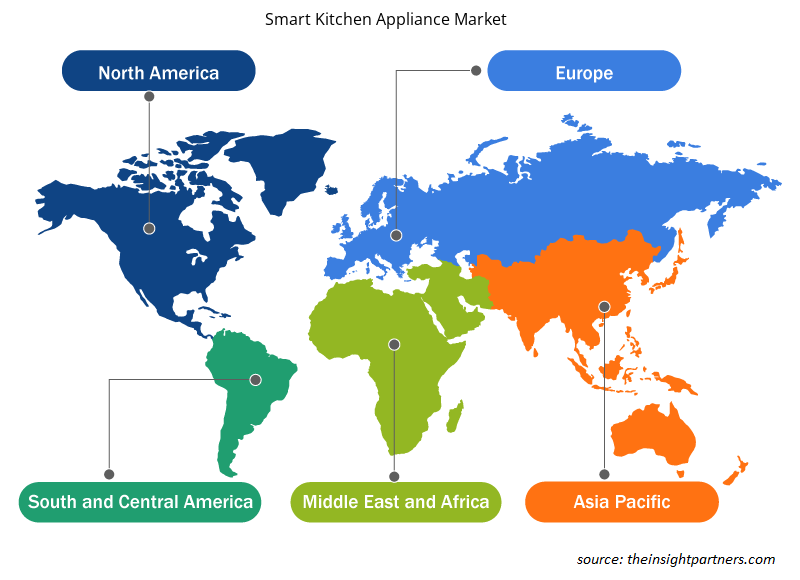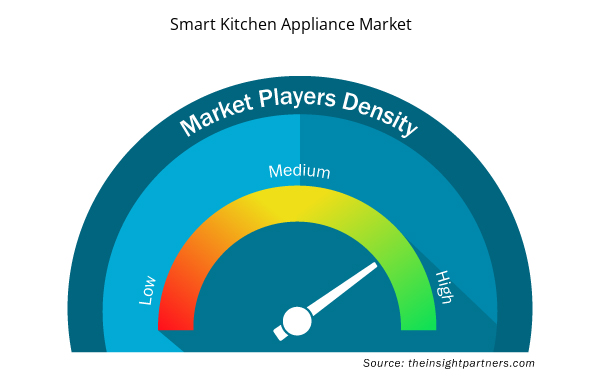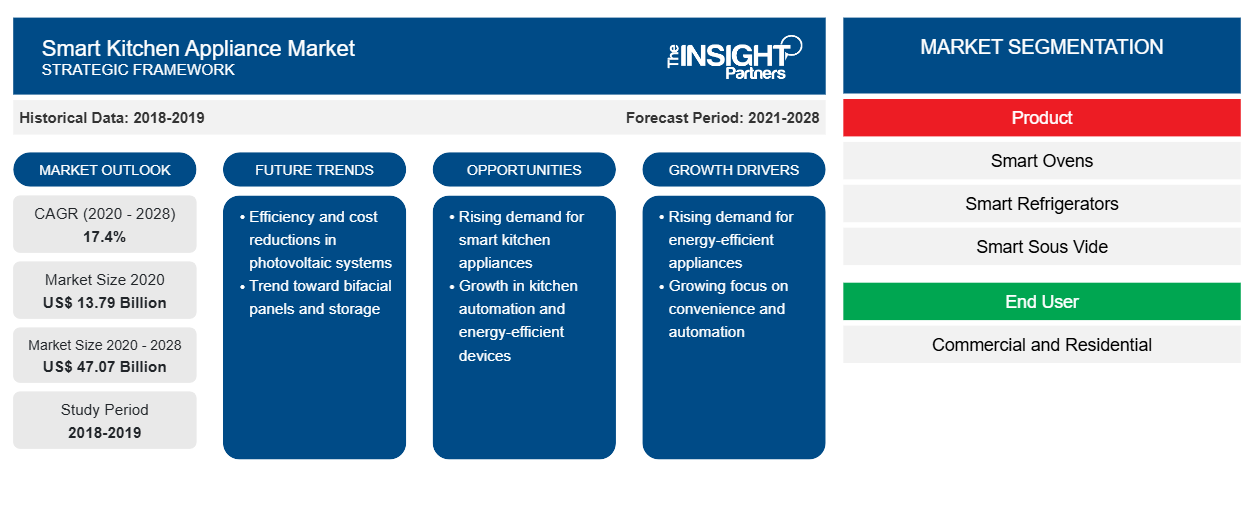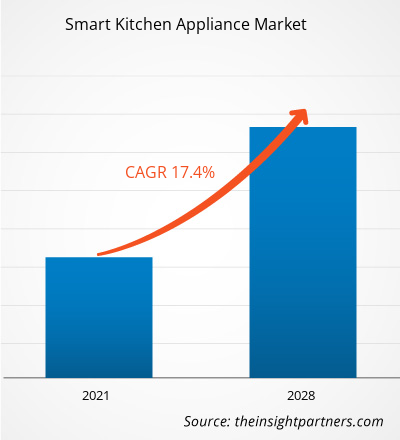من المتوقع أن ينمو سوق الأجهزة المنزلية الذكية العالمي من 13،786.0 مليون دولار أمريكي في عام 2020 إلى 47،071.2 مليون دولار أمريكي بحلول عام 2028؛ ومن المتوقع أن يسجل معدل نمو سنوي مركب بنسبة 17.4٪ خلال الفترة 2020-2028.
فعالية التكلفة والقدرة على التواصل للأجهزة الذكية للمطبخ
الأجهزة الذكية للمطبخ هي تقنيات حديثة مبتكرة تكتسب أهمية كبيرة في الدول المتقدمة والنامية. وفقًا لتقرير Cisco Internet Report، ستستحوذ المنازل المتصلة على حصة 48% عبر جميع تطبيقات إنترنت الأشياء (IoT). توفر الأجهزة الذكية للمطبخ العديد من الفوائد مثل الفعالية من حيث التكلفة والقدرة على الاتصال والسلامة والراحة لأصحابها، وبالتالي تكتسب زخمًا بين المستخدمين النهائيين.
إن الاستثمارات الأولية نحو شراء أجهزة المطبخ الذكية مرتفعة. ومع ذلك، تساعد هذه الأجهزة العملاء على تقليل التكاليف المتكررة المرتبطة بالصيانة الدورية واستهلاك الطاقة على المدى الطويل. توفر الأجهزة الإلكترونية أو الكهربائية التقليدية أو الحديثة طاقة أقل ولكنها تتطلب صيانة دورية وتتكبد تكاليف عالية. يتيح دمج تقنيات الاستشعار في أجهزة المطبخ الذكية للأجهزة استشعار الأداء وتنبيه المالكين في حالة حدوث أي أعطال. يقلل هذا العامل من التكاليف المتكررة. على سبيل المثال، LG ThinQ هو تطبيق للهواتف الذكية تقدمه شركة LG Electronics لأجهزتها الذكية. تعمل الأجهزة الذكية بميزات التشخيص الذاتي، ويمكن للمستخدمين النهائيين الوصول إلى نتائج التشخيص باستخدام تطبيق LG ThinQ. علاوة على ذلك، يوفر التطبيق تعليمات استكشاف الأخطاء وإصلاحها اللازمة للمستخدمين لتشخيص المشكلات، مما يلغي الحاجة إلى الاتصال بموظفي الإصلاح للمشكلات البسيطة. يسهل انخفاض النفقات المتكررة على العديد من المستخدمين النهائيين شراء أجهزة المطبخ الذكية هذه.
وبالمثل، هناك ميزة أخرى للأجهزة الذكية للمطبخ وهي القدرة على التواصل عبر الشبكات اللاسلكية. حيث يمكن لهذه الأجهزة أن تتواصل مع بعضها البعض ومع المالك من خلال الهواتف الذكية للمالك. وتمكن التقنيات الذكية المالكين من التحكم في الأجهزة ومراقبتها والوصول إليها عن بعد. وتسمح الأجهزة الذكية للمطبخ مثل الأفران الذكية للمالك بإيقاف تشغيل الموقد أو تشغيله من الهاتف الذكي للمالك، مما يزيد من الراحة. وتزيد هذه الميزة من الطلب عليها بين المستخدمين النهائيين. كما أن دمج أجهزة الاستشعار المختلفة والكاميرات المدمجة، يسهل على المالك تحديث قائمة التسوق.
بالإضافة إلى ذلك، تحتوي الثلاجات الذكية على شاشات تستخدم كدفاتر ملاحظات وللتحقق من درجة الحرارة ونمط استهلاك الطاقة. يمكن لأصحاب الثلاجات الذكية التحكم في الثلاجات وإدارتها بسهولة وفقًا لأداء الثلاجة والتبديل بين الأوضاع المختلفة من خلال الهواتف الذكية. تتيح هذه المزايا للثلاجات الذكية للعملاء شراء ثلاجات ذكية للأغراض التجارية والسكنية، وبالتالي تعزيز نمو سوق الأجهزة الذكية للمطبخ .
قم بتخصيص هذا التقرير ليناسب متطلباتك
ستحصل على تخصيص لأي تقرير - مجانًا - بما في ذلك أجزاء من هذا التقرير، أو تحليل على مستوى الدولة، وحزمة بيانات Excel، بالإضافة إلى الاستفادة من العروض والخصومات الرائعة للشركات الناشئة والجامعات
- احصل على أهم اتجاهات السوق الرئيسية لهذا التقرير.ستتضمن هذه العينة المجانية تحليلاً للبيانات، بدءًا من اتجاهات السوق وحتى التقديرات والتوقعات.
تأثير جائحة كوفيد-19 على سوق الأجهزة الذكية للمطبخ
وفقًا لجمعية صناعة المكونات الإلكترونية، تسبب فيروس كورونا المستجد في تأخير وتعطيل سلسلة التوريد وإصدارات المنتجات والأحداث وغيرها من الأنشطة المتعلقة بالصناعة. واضطر العديد من مصنعي الإلكترونيات إلى إيقاف وحدات التصنيع مؤقتًا بسبب تدابير الاحتواء والتوافر المحدود للمكونات والمواد الخام. علاوة على ذلك، عانى مصنعو المنتجات الإلكترونية وأشباه الموصلات المختلفة، بما في ذلك أجهزة المطبخ الذكية، من تأخير في الجداول الزمنية المحددة، مما أثر سلبًا على سلسلة التوريد لسوق أجهزة المطبخ الذكية. ومع ذلك، بدأت سلسلة التوريد لسوق أجهزة المطبخ الذكية في الاستقرار في أواخر الربع الرابع من عام 2020، مع إعادة فتح الاقتصاد واكتساب السوق زخمًا إيجابيًا من عام 2021.
رؤى حول سوق أجهزة المطبخ الذكية
نمو كبير في مشاريع المنازل الذكية والفنادق الذكية
يشهد قطاع البناء العالمي طلبًا كبيرًا على المنازل المتصلة بالأجهزة والأجهزة المتقدمة تقنيًا. وقد قطعت الدول المتقدمة مثل الولايات المتحدة والمملكة المتحدة والدول النامية مثل الصين واليابان وكوريا الجنوبية خطوات مثيرة للاهتمام في تطوير المنازل الذكية. وشهد السوق الأمريكي نموًا كبيرًا في عدد المنازل الذكية، ومن المتوقع أن تشهد البلاد اتجاهات مماثلة في السنوات القادمة. إن التحول السريع في عقلية سكان الولايات المتحدة يؤثر بشدة على نمو الأجهزة المنزلية الذكية مثل مكبرات الصوت الذكية، ومنظمات الحرارة الذكية، والإضاءة الذكية، وأجهزة الأمان الذكية. ووفقًا لـ Alarm.org، اعترف 57٪ من الأمريكيين أنه باستخدام المنتجات الذكية، يمكنهم توفير حوالي 30 دقيقة من وقتهم. يستخدم حوالي 47٪ من جيل الألفية منتجات المنزل الذكي. ويتزايد اعتماد هذه الأجهزة باستمرار في الولايات المتحدة والعالم. يفتح انتشار هذه الأجهزة الذكية آفاق النمو لأجهزة المطبخ الذكية، حيث تعد هذه الأجهزة من بين الأدوات المنزلية الضرورية. ونتيجة للتغير في عقلية سكان العالم، وخاصة بين سكان البلدان المتقدمة وعدد قليل من البلدان النامية، فمن المتوقع أن يكون مستقبل أجهزة المطبخ الذكية بارزًا.
كما أن صناعة الضيافة في مناطق جغرافية مختلفة تستعين بتقنيات الروبوتات والتقنيات المتصلة لتعزيز رضا العملاء. تعد أجهزة التلفزيون الذكية والغرف التي يتم التحكم فيها صوتيًا وتخزين الأمتعة الآلي والبواب الرقمي من بين أبرز تقنيات الفنادق الذكية في الوقت الحالي. تُظهِر إدارات الفنادق المختلفة اهتمامًا لائقًا بتحويل مطابخها إلى مطابخ ذكية من خلال شراء أجهزة المطبخ الذكية. يتيح دمج التقنيات المستندة إلى السحابة والهواتف الذكية لأصحاب الفنادق والمطاعم التحكم عن بُعد في أجهزة المطبخ التجارية ومراقبتها، مما يسهل تقدم سوق أجهزة المطبخ الذكية في السيناريو الحالي.
رؤى السوق القائمة على المنتج
بناءً على المنتج، يتم تقسيم سوق أجهزة المطبخ الذكية إلى أفران ذكية وثلاجات ذكية وطهي ذكي وعصارات وخلاطات ذكية ومواقد ذكية وروبوتات طهي ومواقد ذكية وأفران ومواقد ذكية ومتكاملة وغيرها. تصدرت شريحة الثلاجات الذكية سوق أجهزة المطبخ الذكية بحصة بلغت 33.0٪ في عام 2020. تشهد سوق أجهزة المطبخ الذكية ارتفاعًا بسبب الطلب الكبير على الثلاجات الذكية والأفران الذكية في البلدان المتقدمة والنامية، وأسلوب الحياة المحسن، والبنية التحتية المحسنة للإنترنت، والنمو الكبير في إنترنت الأشياء (IoT)، وارتفاع الطلب على الأجهزة أو الأجهزة المتصلة في المطابخ السكنية والتجارية.
استحوذ قطاع الثلاجات الذكية على أكبر حصة في سوق الأجهزة الذكية العالمية للمطبخ في عام 2018 ومن المتوقع أن يهيمن على السوق خلال الفترة 2021-2028. من ناحية أخرى، من المتوقع أن ينمو الطلب على الأفران الذكية بشكل كبير على مر السنين، مما يتنبأ بمستقبل واعد للقطاع من عام 2021 إلى عام 2028.
رؤى السوق القائمة على الاتصال
بناءً على الاتصال، يتم تقسيم سوق أجهزة المطبخ الذكية إلى Wi-Fi وBluetooth. تصدرت شريحة Wi-Fi سوق أجهزة المطبخ الذكية بحصة بلغت 77.3% في عام 2020. ومن المتوقع أن تستحوذ على حصة 79.0% بحلول عام 2028.
أصبحت الأجهزة المنزلية أكثر ذكاءً مع دمج أجهزة الاستشعار المتقدمة ولوحات العرض التفاعلية والكاميرات وغيرها من التقنيات. وقد ساعد دمج هذه التقنيات الشركات المصنعة على اكتساب قدر كبير من جذب العملاء والإيرادات. وقد مكن هذا الشركات المصنعة من ترقية خطوط منتجاتها بتقنيات إضافية مثل تقنية الاتصال عبر شبكة Wi-Fi.
لقد أصبحت تقنية Wi-Fi مكونًا أساسيًا للمنازل في الوقت الحاضر عبر المناطق الجغرافية. يدمج مصنعو أجهزة المطبخ الذكية منتجاتهم بشكل متزايد مع حلول تقنية الاتصال التي تدعم تقنية Wi-Fi، والتي تسمح للمالكين بتشغيل ومراقبة أجهزة الطهي الخاصة بهم من مواقع بعيدة. تساعد أجهزة الطهي الذكية التي تدعم تقنية Wi-Fi المالك على التحكم في ومراقبة معلمتين رئيسيتين - درجة الحرارة والوقت. أثرت هذه الفوائد على المستخدمين النهائيين السكنيين والتجاريين لشراء أجهزة مطبخ ذكية مزودة بتقنية اتصال Wi-Fi. أدى زيادة المشتريات إلى نمو السوق. تلعب البنية التحتية للإنترنت المحسّنة بسرعة دورًا حاسمًا في نمو أجهزة المطبخ الذكية المزودة بتقنية Wi-Fi. وفقًا لتقرير Cisco السنوي للإنترنت، ستشكل أجهزة إنترنت الأشياء 50٪ من جميع الأجهزة المتصلة بالشبكة وحوالي ثلثها سيكون لاسلكيًا. ومن المتوقع أن يؤدي هذا العامل إلى تغذية نمو أجهزة المطبخ الذكية المزودة بتقنية اتصال Wi-Fi في السنوات القادمة.
تعد الأفران الذكية والثلاجات الذكية ومواقد الطهي الذكية وآلات بيع القهوة الذكية والعصارات والخلاطات الذكية من بين الأجهزة الذكية للمطبخ المزودة بتقنية Wi-Fi المتوفرة في السوق. إن الطلب المتزايد من المستهلكين على دمج أجهزة المطبخ بتقنية اتصال Wi-Fi يدفع إلى استيعاب تقنية اتصال Wi-Fi في أجهزة المطبخ الذكية. يعد هذا العامل محفزًا رئيسيًا لسوق أجهزة المطبخ الذكية المزودة بتقنية Wi-Fi في السيناريو الحالي.
الأجهزة الذكية للمطبخ
رؤى إقليمية حول سوق أجهزة المطبخ الذكية
لقد قام المحللون في Insight Partners بشرح الاتجاهات والعوامل الإقليمية المؤثرة على سوق الأجهزة الذكية للمطبخ طوال فترة التوقعات بشكل شامل. يناقش هذا القسم أيضًا قطاعات سوق الأجهزة الذكية للمطبخ والجغرافيا في جميع أنحاء أمريكا الشمالية وأوروبا ومنطقة آسيا والمحيط الهادئ والشرق الأوسط وأفريقيا وأمريكا الجنوبية والوسطى.

- احصل على البيانات الإقليمية المحددة لسوق أجهزة المطبخ الذكية
نطاق تقرير سوق أجهزة المطبخ الذكية
| سمة التقرير | تفاصيل |
|---|---|
| حجم السوق في عام 2020 | 13.79 مليار دولار أمريكي |
| حجم السوق بحلول عام 2028 | 47.07 مليار دولار أمريكي |
| معدل النمو السنوي المركب العالمي (2020 - 2028) | 17.4% |
| البيانات التاريخية | 2018-2019 |
| فترة التنبؤ | 2021-2028 |
| القطاعات المغطاة | حسب المنتج
|
| المناطق والدول المغطاة | أمريكا الشمالية
|
| قادة السوق وملفات تعريف الشركات الرئيسية |
|
كثافة اللاعبين في سوق الأجهزة الذكية للمطبخ: فهم تأثيرها على ديناميكيات الأعمال
يشهد سوق أجهزة المطبخ الذكية نموًا سريعًا، مدفوعًا بالطلب المتزايد من المستخدم النهائي بسبب عوامل مثل تفضيلات المستهلكين المتطورة والتقدم التكنولوجي والوعي المتزايد بفوائد المنتج. ومع ارتفاع الطلب، تعمل الشركات على توسيع عروضها والابتكار لتلبية احتياجات المستهلكين والاستفادة من الاتجاهات الناشئة، مما يؤدي إلى زيادة نمو السوق.
تشير كثافة اللاعبين في السوق إلى توزيع الشركات أو المؤسسات العاملة في سوق أو صناعة معينة. وهي تشير إلى عدد المنافسين (اللاعبين في السوق) الموجودين في مساحة سوق معينة نسبة إلى حجمها أو قيمتها السوقية الإجمالية.
الشركات الرئيسية العاملة في سوق أجهزة المطبخ الذكية هي:
- ايه بي الكترولوكس
- مجموعة بريفيلي المحدودة
- شركة BSH Hausgerate GmbH
- أجهزة GE
- شركة إل جي للإلكترونيات
إخلاء المسؤولية : الشركات المذكورة أعلاه ليست مرتبة بأي ترتيب معين.

- احصل على نظرة عامة على أهم اللاعبين الرئيسيين في سوق الأجهزة الذكية للمطبخ
يتبنى اللاعبون العاملون في سوق أجهزة المطبخ الذكية استراتيجيات مثل عمليات الدمج والاستحواذ ومبادرات السوق للحفاظ على مواقعهم في السوق. وفيما يلي بعض التطورات التي قام بها اللاعبون الرئيسيون:
- في نوفمبر 2019، وسعت شركة إلكترولوكس تعاونها مع جوجل من خلال دمج منتجات المطبخ المتصلة في أوروبا مع مساعد جوجل، مما يتيح للمستهلكين التحكم في المنتجات عبر الأوامر الصوتية.
يتم تقسيم سوق الأجهزة الذكية العالمية للمطبخ إلى المنتج والمستخدم النهائي والاتصال. بناءً على المنتج، يتم تقسيم سوق الأجهزة الذكية للمطبخ إلى أفران ذكية وثلاجات ذكية وطهي ذكي وعصارات وخلاطات ذكية وموقد ذكي وروبوتات طهي ومواقد ذكية وأفران ومواقد ذكية ومتكاملة وغيرها. بناءً على المستخدم النهائي، يتم تصنيف السوق إلى تجاري وسكني. من خلال الاتصال، يتم تقسيم سوق الأجهزة الذكية للمطبخ إلى Wi-Fi وBluetooth.
تعد شركة Electrolux AB؛ وBSH Hausgeräte GmbH؛ وGE Appliances؛ وLG Electronics؛ وKoninklijke Philips NV؛ وPanasonic Corporation؛ وSamsung Electronics Co., Ltd؛ وBreville Group Limited؛ وWhirlpool Corporation؛ وVita-Mix Corporation من أهم اللاعبين في سوق أجهزة المطبخ الذكية الذين تم أخذهم في الاعتبار في دراسة البحث. بالإضافة إلى ذلك، تمت دراسة وتحليل العديد من اللاعبين الآخرين المهمين في سوق أجهزة المطبخ الذكية في تقرير البحث هذا للحصول على نظرة شاملة لسوق أجهزة المطبخ الذكية العالمية ونظامها البيئي.
- التحليل التاريخي (سنتان)، السنة الأساسية، التوقعات (7 سنوات) مع معدل النمو السنوي المركب
- تحليل PEST و SWOT
- حجم السوق والقيمة / الحجم - عالميًا وإقليميًا وقطريًا
- الصناعة والمنافسة
- مجموعة بيانات Excel



Report Coverage
Revenue forecast, Company Analysis, Industry landscape, Growth factors, and Trends

Segment Covered
This text is related
to segments covered.

Regional Scope
North America, Europe, Asia Pacific, Middle East & Africa, South & Central America

Country Scope
This text is related
to country scope.
الأسئلة الشائعة
growth in internet penetration and awareness related to the smart kitchen appliances among the population in developing countries are helping customers in these regions to procure an increased number of smart kitchen appliances, thereby, creating growth opportunities for the smart kitchen appliances market players.
The connected home devices industry has witnessed significant growth across the globe in the current scenario, and the same is expected to be adopted in large quantities in the coming years. Several manufacturers of electronics and electrical equipment are increasingly emphasizing on the development of smart kitchen appliances to benefit their customers with advanced technologies. The presence of long-established and industry recognized manufacturers in the smart kitchen appliance market is facilitating the market to proliferate quickly. Additionally, rising disposable income among the middle-class societies in developed countries and developing countries is influencing the residential end users to adopt newer technologies such as intelligent kitchen appliances, which is paving the growth path for smart kitchen appliance market.
The major companies in smart kitchen appliances includes Whirlpool Corporation; Breville Group Limited; Samsung Electronics Co., Ltd.; Electrolux AB; and BSH Hausgeräte GmbH.
The smart refrigerator is expected to dominate the market during the forecast period. Smart refrigerators are also known internet refrigerators which are embedded with advanced technologies to sense the stored products and keep a track of the stock of products. The ability to communicate with the end users is a prime benefit of smart refrigerators. Various smart refrigerators have large screens which facilitate as note pads, calendar, leave notes, internet browsing, voice assistance, and playing music among others. Also, smart refrigerator allows end user to track the checks expiration dates of most of groceries and also suggests recipes according to groceries available in refrigerator. The sensors embedded in these refrigerators also senses the temperatures outside and inside the fridge,and adjusts the temperatures inside the refrigerators. Additionally, in case of any malfunction, the refrigerators alert the owner immediately which simplifies operational maintenance.
The Wi-Fi is expected to dominate the market during the forecast period. Wi-Fi has become an essential household component nowadays across geographies. Pertaining to this, the manufacturers of smart kitchen appliances are increasingly integrating their products with Wi-Fi enabled Connectivity Technology solutions, which facilitates the owner’s to operate and monitor their cooking appliances from a remote location. Wi-Fi enabled smart cooking appliances helps the owner to control and monitor two major parameters namely; temperature, and time. These benefits have influenced both residential and commercial end users to procure smart kitchen appliances with Wi-Fi Connectivity Technology. Increasing procurement has resulted in market growth. Rapidly improving internet infrastructures in developed countries and developing countries is playing a crucial role in growth of Wi-Fi enabled smart kitchen appliances. According to Cisco Annual Internet Report, IoT devices will account for 50 percent of all networked devices and approximal one-third will be wireless. This factor is anticipated to fuel the growth of smart kitchen appliances with Wi-Fi Connectivity Technology in the forthcoming years.
In 2020, APAC accounted for the highest market share in the global market and is also expected to grow with the highest CAGR over the forecast period.
The List of Companies - Smart Kitchen Appliance Market
- AB Electrolux
- Breville Group Limited
- BSH Hausgerate GmbH
- GE Appliance
- LG Electronics inc.
- Panasonic corporation
- KONINKLIJKE PHILIPS N.V.
- Samsung electronics Co., Ltd.
- Vita-Mix Corporation
- Whirlpool Corporation
The Insight Partners performs research in 4 major stages: Data Collection & Secondary Research, Primary Research, Data Analysis and Data Triangulation & Final Review.
- Data Collection and Secondary Research:
As a market research and consulting firm operating from a decade, we have published and advised several client across the globe. First step for any study will start with an assessment of currently available data and insights from existing reports. Further, historical and current market information is collected from Investor Presentations, Annual Reports, SEC Filings, etc., and other information related to company’s performance and market positioning are gathered from Paid Databases (Factiva, Hoovers, and Reuters) and various other publications available in public domain.
Several associations trade associates, technical forums, institutes, societies and organization are accessed to gain technical as well as market related insights through their publications such as research papers, blogs and press releases related to the studies are referred to get cues about the market. Further, white papers, journals, magazines, and other news articles published in last 3 years are scrutinized and analyzed to understand the current market trends.
- Primary Research:
The primarily interview analysis comprise of data obtained from industry participants interview and answers to survey questions gathered by in-house primary team.
For primary research, interviews are conducted with industry experts/CEOs/Marketing Managers/VPs/Subject Matter Experts from both demand and supply side to get a 360-degree view of the market. The primary team conducts several interviews based on the complexity of the markets to understand the various market trends and dynamics which makes research more credible and precise.
A typical research interview fulfils the following functions:
- Provides first-hand information on the market size, market trends, growth trends, competitive landscape, and outlook
- Validates and strengthens in-house secondary research findings
- Develops the analysis team’s expertise and market understanding
Primary research involves email interactions and telephone interviews for each market, category, segment, and sub-segment across geographies. The participants who typically take part in such a process include, but are not limited to:
- Industry participants: VPs, business development managers, market intelligence managers and national sales managers
- Outside experts: Valuation experts, research analysts and key opinion leaders specializing in the electronics and semiconductor industry.
Below is the breakup of our primary respondents by company, designation, and region:

Once we receive the confirmation from primary research sources or primary respondents, we finalize the base year market estimation and forecast the data as per the macroeconomic and microeconomic factors assessed during data collection.
- Data Analysis:
Once data is validated through both secondary as well as primary respondents, we finalize the market estimations by hypothesis formulation and factor analysis at regional and country level.
- Macro-Economic Factor Analysis:
We analyse macroeconomic indicators such the gross domestic product (GDP), increase in the demand for goods and services across industries, technological advancement, regional economic growth, governmental policies, the influence of COVID-19, PEST analysis, and other aspects. This analysis aids in setting benchmarks for various nations/regions and approximating market splits. Additionally, the general trend of the aforementioned components aid in determining the market's development possibilities.
- Country Level Data:
Various factors that are especially aligned to the country are taken into account to determine the market size for a certain area and country, including the presence of vendors, such as headquarters and offices, the country's GDP, demand patterns, and industry growth. To comprehend the market dynamics for the nation, a number of growth variables, inhibitors, application areas, and current market trends are researched. The aforementioned elements aid in determining the country's overall market's growth potential.
- Company Profile:
The “Table of Contents” is formulated by listing and analyzing more than 25 - 30 companies operating in the market ecosystem across geographies. However, we profile only 10 companies as a standard practice in our syndicate reports. These 10 companies comprise leading, emerging, and regional players. Nonetheless, our analysis is not restricted to the 10 listed companies, we also analyze other companies present in the market to develop a holistic view and understand the prevailing trends. The “Company Profiles” section in the report covers key facts, business description, products & services, financial information, SWOT analysis, and key developments. The financial information presented is extracted from the annual reports and official documents of the publicly listed companies. Upon collecting the information for the sections of respective companies, we verify them via various primary sources and then compile the data in respective company profiles. The company level information helps us in deriving the base number as well as in forecasting the market size.
- Developing Base Number:
Aggregation of sales statistics (2020-2022) and macro-economic factor, and other secondary and primary research insights are utilized to arrive at base number and related market shares for 2022. The data gaps are identified in this step and relevant market data is analyzed, collected from paid primary interviews or databases. On finalizing the base year market size, forecasts are developed on the basis of macro-economic, industry and market growth factors and company level analysis.
- Data Triangulation and Final Review:
The market findings and base year market size calculations are validated from supply as well as demand side. Demand side validations are based on macro-economic factor analysis and benchmarks for respective regions and countries. In case of supply side validations, revenues of major companies are estimated (in case not available) based on industry benchmark, approximate number of employees, product portfolio, and primary interviews revenues are gathered. Further revenue from target product/service segment is assessed to avoid overshooting of market statistics. In case of heavy deviations between supply and demand side values, all thes steps are repeated to achieve synchronization.
We follow an iterative model, wherein we share our research findings with Subject Matter Experts (SME’s) and Key Opinion Leaders (KOLs) until consensus view of the market is not formulated – this model negates any drastic deviation in the opinions of experts. Only validated and universally acceptable research findings are quoted in our reports.
We have important check points that we use to validate our research findings – which we call – data triangulation, where we validate the information, we generate from secondary sources with primary interviews and then we re-validate with our internal data bases and Subject matter experts. This comprehensive model enables us to deliver high quality, reliable data in shortest possible time.


 احصل على عينة مجانية لهذا التقرير
احصل على عينة مجانية لهذا التقرير